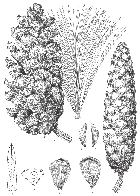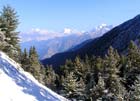Conservation Status

Pinus wallichiana
A.B. Jackson 1938
Common names
Bhutan pine, Himalayan white pine (Farjon 1984).
Taxonomic notes
Two varieties:
- Pinus wallichiana var. parva K.C.Sahni (1990). Type: India, Arunachal Pradesh, Kameng District, Tawang, R. N. Loganey 6 (holotype DD). Syn. Pinus parva (K.C.Sahni) R.C.Srivast. non Ammosov (fossil name), Pinus arunachalensis R.C.Srivast. (2017), Pinus wallichiana subsp. parva (K.C.Sahni) Silba.
- Pinus wallichiana var. wallichiana. Type: Illustration in Lambert (1824) as Pinus excelsa. See POWO for synonyms.
Var. parva is currently accepted by POWO at species rank as Pinus arunachalensis, but I can find no reference to it in any published source other than those cited here, and no treatment of it that can provide a molecular, morphological, or other basis for assigning species rank. Farjon (2010) gave it varietal rank and notes that the sole description is based on a single type specimen. In short, there is no reason not to treat it at varietal rank, as Sahni (1990) did. For discussion of systematics relative to other species in subsection Strobus, see Phylogeny of East Asian white pines.
Description
Tree to 50+ m tall with straight trunk and short, downcurved branches. Branches longer in solitary trees, creating a dome-like crown. Bark on young trees smooth, becoming fissured with age. Branches in regularly spaced whorls, smooth. Young shoots glaucous, later turning pale grey-green, smooth, ribbed, darkening with age. Winter buds grey with an orange tinge, ovoid-conic, pointed. Leaves in fascicles of 5, basal sheaths deciduous, 15-20 cm long, often curved at the base, slender, flexible, abaxial side green, adaxial side with multiple bluish-white stomatal lines; usually pendant but in some trees spreading. Male strobili on lower branches, often in dense clusters on younger twigs. Female cones in groups of 1-6, 20-30 cm long, erect when young but later pendant [see photo], bluish-green when young, maturing to light brown with pale brown apophyses. Cone scales wedge-shaped, wide near the apex, apophysis grooved, ending in a blunt umbo; basal scales usually not, or only slightly, reflexed, very resinous (Farjon 1984). See García Esteban et al. (2004) for a detailed characterization of the wood anatomy.
Var. parva has leaves 6-11 cm long, seed cones ca. 10 cm long, and seeds ca. 3 mm long with a wing that is 10 mm long and 5 mm wide. Var. wallichiana has leaves 10-20 cm long, seed cones 15-30 cm long, and seeds 4 mm long with a wing that is 15-35 mm long and 8-10 mm wide (Farjon 2010).
Distribution and Ecology
Himal: southern flank, from Afghanistan through Pakistan, India, Tibet (China: Xizang), Nepal and Bhutan to Burma. Found in valleys and foothills at elevations of 1800-3900 m, sometimes in pure stands but often in association with conifers including Cedrus deodara, Abies pindrow, Picea smithiana and Juniperus excelsa subsp. polycarpos, and with broadleaved species including Quercus semecarpifolia, Betula utilis, ard Acer and Ilex species. It may also be associated with the more narrowly distributed pines Pinus kesiya and P. roxburghii. It is shade-intolerant, thus early seral (Farjon 1984, Sahni 1990, Singh and Yadav 2000). Hardy to Zone 8 (cold hardiness limit between -12.1°C and -6.7°C) (Bannister and Neuner 2001).
Var. parva is only known from the Tawang and West Kameng areas of Arunachal Pradesh (Srivastava 2017). Farjon (2010) describes it as a "high altitude form" but provides no specifics.
Remarkable Specimens
The oldest known living specimen, 689 years, was documented in a tree-ring chronology covering the period 1317-2005 (crossdated after 1452), collected at Astore-Rama, Pakistan by Edward R. Cook, Jonathan G. Palmer, and Moinuddin Ahmed (doi.org/10.25921/ycsx-9h67). This site was used in a dendroclimatic temperature reconstruction (PAGES 2k Consortium 2013).
Ethnobotany
This is an important timber tree in parts of the Himalaya, producing an excellent wood for paneling, veneers, furniture, and finish carpentry; also used traditionally for boxes, construction, and railroad ties, although in modern times less valuable woods are likely targeted for those purposes. The resin was formerly tapped for naval stores. It is also a popular ornamental tree in India, western Europe, and North America; a number of cultivars have been developed (Farjon 2010).
Exploratory work in dendrochronology by Bhattacharyya et al. (1992) found that this species crossdates well and its growth is reasonably well correlated with climate. Quite a few other studies have also been done, mostly since 1985, mostly focusing either on general exploratory work or on sampling for dendroclimatic data networks. A study of glacier fluctuations by Singh and Yadav (2000) developed a live-tree tree ring chronology extending from 1590 to 1999, indicating that maximum ages exceed 410 years.
Observations
Vladimir Dinets (E-mail, 2004.11.14) reports that Kalam, in Pakistan's Swat Valley, has a large forest of Cedrus deodara with some Picea smithiana and Pinus wallichiana. He also found it growing along the trail to Nanga Parbat Base Camp. "The trailhead is accessible from Gilgit by a hired jeep, or from Raikot Bridge on the Karakoram Highway by hitchhiking (early morning only). Near the trailhead are some Pinus gerardiana, Juniperus semiglobosa and Cupressus torulosa, higher up—Pinus wallichiana and Picea smithiana (slim, but up to 50 m tall)." He also saw growing on north-facing slopes in Ayubia National Park near Muree, 2-3 hours from Islamabad). See Dinets (2004) for further detail.
Remarks
The epithet honors Danish botanist N. W. Wallich (1786-1854). Lambert (1824) writes "I am indebted to my excellent friend Dr. Wallich for numerous fine specimens of it in various states."
Citations
Bhattacharyya, A., LaMarche, Jr., V.C., Hughes, M.K. 1992. Tree-ring chronologies from Nepal. Tree-Ring Bulletin 52:59-66.
Dinets, Vladimir. 2004. Ramadan in Pakistan. http://dinets.travel.ru/eibex.htm, accessed 2004.11.28, now defunct.
Lambert, Aylmer Bourke. 1824. A description of the genus Pinus, illustrated with figures, directions relative to the cultivation, and remarks on the uses of the several species. Vol. 2. London: J. White. Available: Biodiversity Heritage Library, accessed 2025.01.27.
PAGES 2k Consortium. 2013. Continental-scale temperature variability during the past two millennia. Nature Geoscience 6:339-346. doi: 10.1038/NGEO1797.
Sahni, K. C. 1990. Gymnosperms of India and Adjacent Countries. Dehra Dun: Bishen Singh and Mahendra Pal Singh Pub., p. 169.
Singh, J., and R.R. Yadav. 2000. Tree-ring indications of recent glacier fluctuations in Gangotri, western Himalaya, India. Current Science 79(11): 1598-1601.
Srivastava, R. C., 2017. Notes on indigenous pines of India. Int. J. Curr. Res. Biosci. Plant Biol. 4(5):85-87. https://doi.org/10.20546/ijcrbp.2017.405.012.
See also
Elwes and Henry 1906-1913 at the Biodiversity Heritage Library (as P. excelsa). This series of volumes, privately printed, provides some of the most engaging descriptions of conifers ever published. Although they only treat species cultivated in the U.K. and Ireland, and the taxonomy is a bit dated, still these accounts are thorough, treating such topics as species description, range, varieties, exceptionally old or tall specimens, remarkable trees, and cultivation. Despite being over a century old, they are generally accurate, and are illustrated with some remarkable photographs and lithographs.





